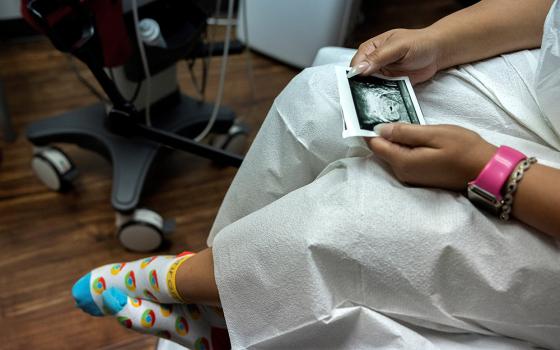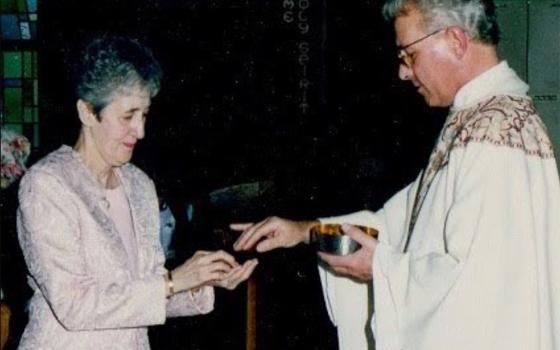U.S. flags are taped on a shipment of Johnson & Johnson COVID-19 vaccines in Bogota, Colombia, July 1. (CNS photo/Nathalia Angarita, Reuters)
I finally had the opportunity to visit the grave of my longtime mentor and dear friend, Msgr. Richard Guastella, an early casualty of the pandemic. A pastor in the New York Archdiocese, he complained of COVID-19 symptoms two weeks after the archbishop cancelled Masses late March 14, 2020. He was hospitalized eight days after funerals were suspended on March 24 and he died in the early hours of Holy Thursday, one week shy of the New York State mask mandate.
The kind of grief that arises when a loved one just disappears unexpectedly drives a stream of "if onlys." If only decisions were made sooner. If only politicians and public health professionals avoided disseminating conflicting guidance. If only church leaders would recognize that sometimes sacred spaces and communal rituals host super-spreader events.
Ironically as I stood in the cemetery, 15 months after my friend's death, grappling with a loss that may or may not have been preventable, the New York archdiocesan newspaper reported, "Since the pandemic has ended, Cardinal Dolan and the archdiocese have made it a priority to have people return to a weekly celebration of Mass in their parish church."
Advertisement
As the country braces for a fourth surge of a virus that owns all seasons, we have yet to account for our dead, let alone learn from their untimely passing. How many ordained and lay ministers have we lost? How many parishioners have died? How many communities of religious women and men are mourning the absence of unprecedented numbers of active and retired members? How many more to come … if only …
With slightly less than 50% of Americans fully vaccinated, the Delta variant of COVID-19 and Lambda on the horizon threaten to push the death toll to numbers rivaling those lost to the 1918 pandemic, approximately 675,000 nationally. The tragedy is compounded by the fact that the overwhelming majority of deaths since the widespread availability of vaccines were and are preventable.
During a CNN interview, Dr. Anthony Fauci noted the potential consequences caused by regional vaccination rate discrepancies, "It's almost like it's going to be two Americas. You're going to have areas where the vaccine is high where there is more than 70% of the population has received at least one dose. When you compare that with areas where you may have 35% of the people vaccinated, you clearly have a high risk of seeing these spikes in those selected areas."
Other studies have focused on the role of partisan divides in vaccine hesitancy demonstrating widening gaps along the lines of Joe Biden voters vs. Donald Trump voters.
A woman prays during the formal installation of Fr. Carlos C. Velasquez as pastor of St. Brigid Church in the Brooklyn borough of New York City June 20. (CNS/Gregory A. Shemitz)
Unvaccinated people cannot be easily reduced to the fallout of political polarization. Issues of access and equity are in part responsible for disparities across racial and ethnic communities that have been historically marginalized in healthcare. More recent trends suggest a narrowing of racial gaps in vaccination rates at the national level, yet Black, Latin@́, Indigenous and Asian communities continue to suffer disproportionately from COVID-19, including dramatic drops in life expectancy.
The Rev. Otis Moss, senior pastor at Trinity United Church of Chicago, captured the impact of the pandemic at the intersection of social viruses that have long plagued the United States, "If you take COVID-19 and pair it with COVID 1619, the original American pandemic, you put those two together and you have a disaster and a tragedy. And that's what we are witnessing."
The notion of "two Americas," as interpreted by some in terms of vaccinated and unvaccinated, as well as filtered through optics of political partisanship, not only excludes minoritized and immigrant communities but fails to recognize "America" as an interconnected hemisphere. The assassination of Haitian president Jovenel Moïse, for example, brought to attention the reality that the country remains the only one in North America without vaccines. Social protests in Cuba also illustrate the impact of inadequate responses to the pandemic in exacerbating political and economic instability.
Tabulations from the World Health Organization (WHO) indicate las Americas are the global frontrunner in the number of COVID-19 cases (75 million) and deaths (almost 2 million). This means that nearly 40% of the world's cases and almost 50% of the deaths occur in this hemisphere, with the U.S. maintaining both the regional and global lead. While over 3.7 billion doses of vaccine have been administered globally, the vast majority of the world remains unvaccinated (over 85%).
The notion of "two Americas," as interpreted by some in terms of vaccinated and unvaccinated, as well as filtered through optics of political partisanship, not only excludes minoritized and immigrant communities but fails to recognize "America" as an interconnected hemisphere.
Clearly we are nowhere near the end of the pandemic. If only our vaccinated and our unvaccinated, our public institutions and our faith communities would realize that false optimism is dangerous, misinformation risks lives and COVID-19 is preventable. Solidarity in responding to the pandemic in local, national and international contexts should be driven by concern for others — loved ones, neighbors, strangers and even enemies, and equally by self-preservation.
Framing public health measures in terms of violations of individual rights and religious liberty is disingenuous with respect to investment in the common good. How many unnecessary deaths can be traced directly or indirectly not only to disinformation on social media or influential Fox News celebrities, but to the vaccine confusion set in motion by some religious leaders including a few Catholic bishops?
Any theologizing through a pandemic is at best provisional, responsive to crisis in the moment without the benefits of prescience hindsight or even the distance necessary to envision a long game. It strikes me, however, that a current theological focus on "real presence" as experienced through in-person celebrations of Eucharist is extraordinarily limited, especially in light of the signs of our global pandemic times.
Initial calls by the U.S. bishops' conference for a eucharistic revival trace in part to a 2019 Pew Research Center study assessing basic religious knowledge of U.S. adults. The study reduced significant knowledge of Catholicism to two questions, purgatory and Eucharist. The poorly worded question on Eucharist offered participants two possible options — though "none of the above" would have been the best response, as neither "symbol" nor "actual" accurately reflected Catholic teaching on real presence.
Curiously the term transubstantiation occurs more times in the Pew final report and in their brief analytic article on the question (five times each) than it appears in the entire Catechism of the Catholic Church, (twice, both times quoting the Council of Trent)! Hyperbolic episcopal tweets and headlines neglected to mention that the number of Catholics surveyed as part of a greater pool of almost 11,000 respondents was 1,835.
A man prays at the entrance of a church during Mass in Port-au-Prince, Haiti, July 11 following the assassination of Haitian President Jovenel Moïse July 7. (CNS/Reuters/Ricardo Arduengo)
A commitment to a multiyear national eucharistic revival motivated in part by limited data, flawed analysis of that data, and no consultation with the people sounds like a churchy equivalent of the Roman poet Juvenal's "panem et circenses." Focus on who can be excluded from the table, sponsor a few processions and distract the U.S. faithful from a colossal failure of the Catholic sacramental imagination in a time of incredible need.
Launching a variety of "Back to Mass" campaigns in dioceses and archdioceses across the country without a clearer understanding of the relationship between our ritual practices and the transmission of a destructive and ever-changing virus is imprudent. Minimizing the anxieties of Catholics around their return to churches while inadequately addressing the prophylactic need for masks in congregational environments where vaccination statuses remain unknown is beyond irresponsible.
Facetious remarks communicate a lack of pastoral sensitivity not invitation. One bishop wrote, "I realize that many Catholics during this COVID period have become accustomed to the ease of attending Mass virtually from the comfort of their own homes and without the inconvenience of busy parking lots, crying children, and crowded pews."
Seriously? The inconvenience of expensive hospital stays, long-term complications and death might better explain the appeal of virtual liturgies.
If flippancy doesn't work to inspire return there is always threat, again from the same bishop: "If I might signal the importance of the Mass in a more negative manner, the Church has consistently taught that baptized Catholics are morally obligated to attend Mass on Sunday and that the conscious missing of Mass, in the absence of a valid excuse, is mortally sinful."
At the heart of the revival and the pleas to return to in-person Mass is the sense that somehow physical proximity is necessary for the divine presence to be real.
At the heart of the revival and the pleas to return to in-person Mass is the sense that somehow physical proximity is necessary for the divine presence to be real. This condescending misconception ultimately fails to appreciate that God's grace and accompaniment know no bounds. What is missed is the efficacious power of the suffering body of Christ that is present virtually — not only through this pandemic, but for decades, for example, as homebound people have long participated in televised Mass ministries.
As long as COVID-19 variants continue to arise, and vaccine hesitancy persists, and most of the world struggles from a lack of access to vaccines and healthcare, the pandemic is not waning, ended, over or done. COVID-19 continues to mark our bodies, individually, corporately and as the body of Christ.
Until there is a census of our pandemic dead, as church, we participate in their disappearance. As sacramental theologian David Power wrote in response to the specter of mass death, "When names are obliterated in the massiveness of numbers counted or hazarded, these very names must be summoned up from the dead."
The evangelization we crave in these times is recognition of the real presence of Christ in suffering and a re-imagining of ourselves, in the image of God, as masked, vaccinated and virtual. If only …








